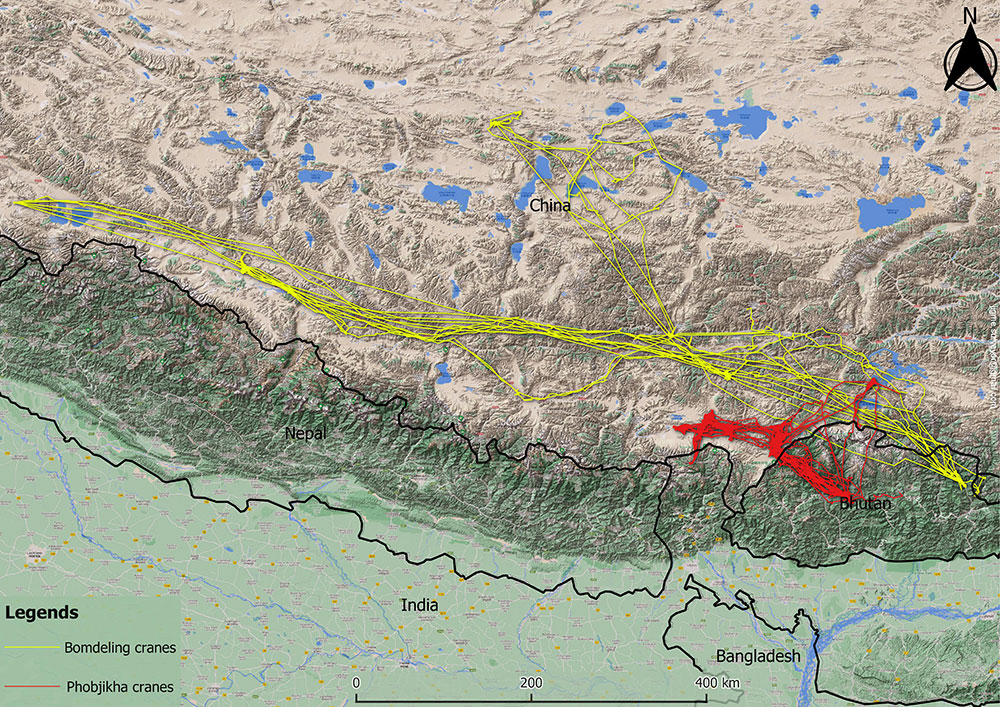The black-necked crane population has doubled in the country, numbering nearly 600
Chhimi Dema
According to a study, the Black-necked Cranes (Grus nigricollis) at Phobjikha and Bumdeling fly in from China and Arunachal Pradesh, India, their summer habitat.
Recent studies of the endangered cranes’ migration routes and breeding grounds found that cranes in Phobjikha spend their summer at Duoqingcuo, China and the birds in Bumdeling travelled more than 1,000km further northwest from Bhutan, along the Yarlung Tsangpo (Brahmaputra) river.
The cranes from Bumdeling also visit Zemingthang in Arunachal Pradesh.
The results were the effort of the Royal Society for Protection of Nature (RSPN), Ugyen Wangchuck Institute for Conservation and Environment Research, and Bumdeling Wildlife Sanctuary who have been tagging cranes in Bumdeling to identify migration corridors; winter, summer, breeding, and stopover sites; and habitat preference.
Tagging the cranes also allows tracking activity patterns and learning their life history.
RSPN officials said that the location data from the tagged cranes will be shared with counterparts in the range countries to assess the status of the habitats to protect them.
The cranes are tagged with solar-power poly-sensored Global Positioning System (GPS), Global System for mobile communication (GSM) or General Packet Radio Services (GPRS) biologgers which are tracking systems designed and implemented for tracking movement of the cranes.
RSPN records show that there are 12 tagged cranes (from two sites) actively transmitting data.
There are 545 black-necked cranes (BNC) in the country today. The highest number of BNC is in Phobjikha with 465 cranes followed by 64 in Bumdeling in Trashiyangtse. Khotokha, Wangdue and Tang, Bumthang have four cranes each; there are seven in Chumey, and one in Dungkar.
BNC conservation since 1990
The current global black-necked crane population has increased from around 7,000 to 11,000 birds since 1990.
In Bhutan, the crane wintering has doubled from around 300 in the 1990s to about 600 cranes because of increased protective mechanisms, conservation intervention, and improved population monitoring and counting protocols.
Records with the RSPN, the focal agency for managing the Phobjikha Conservation Area, show that little was known about the cranes in Bhutan before the efforts of Dasho Paljor Jigme Dorji in Phobjikha Valley in 1986.
Recognising the importance of the habitat for wintering cranes, Phobjikha valley was designated as a conservation area in 1999. The Bumdeling Wildlife Sanctuary was established in 1995 to protect the BNC habitat in the east.
Black-necked cranes are listed under protected bird species in the Forest and Nature Conservation Act of Bhutan 1995, and the Forest and Nature Conservation Rules of Bhutan 2017.
The Department of Forest and Park Service and the RSPN developed a five-year action plan from 2020 to 2024 for BNC conservation in Bhutan.
A memorandum of understanding was also signed between the department and the RSPN to promote biodiversity and ecosystem conservation through collaboration in the field of species and habitat, water resource management and research.
Conservation in Phobjikha and Bumdeling
The RSPN has focused on developmental activities that benefit the people and crane conservation in Phobjikha.
“The programme mainly focused on conserving the cranes’ winter habitat while economically empowering the local community through promoting sustainable livelihood approaches,” a RSPN official said.
Under the RSPN’s species-based conservation programme, conservation of two flagship species in the country, White-bellied Heron (Ardea insignis) and BNC are prioritised.
RSPN finds that the Bumdeling habitat has been observing a declining wintering population of cranes. The trend has been attributed to a decline in foraging grounds from floods.
“Rapid land abandonment by farmers due to crop depredation by wildlife and frequent floods caused the shrinkage of the foraging habitat for the cranes,” said the official. Black-necked cranes forage the post-harvest paddy fields for dropped grains and associated insects.
With funding support from the International Crane Foundation, the RSPN provided electric fencing of about 200km and restored about 25 acres of abandoned paddy fields.
Challenges in BNC conservation
Loss of habitat and environmental degradation are the biggest threats the cranes are facing today which are augmented by anthropogenic pressure and ecological change.
The official said that these pressures are more “serious” in the wintering areas where wetlands have been extensively impacted by agricultural activities such as irrigation projects.
Dam and solar power stations constructions, river channeling, heavy grazing pressure, sedimentation, and industrial pollution, among other factors, were also recognised as challenges in conservation efforts.


